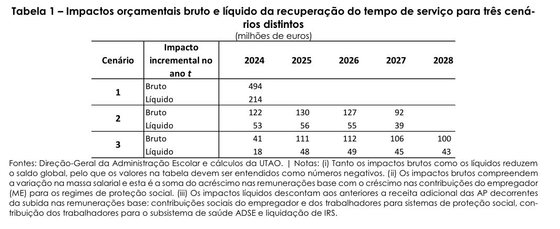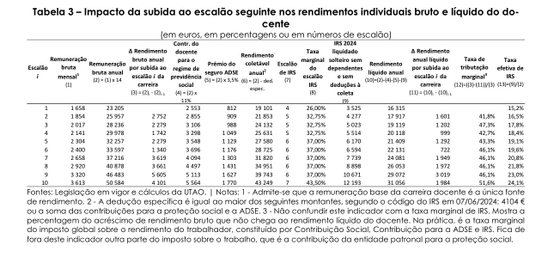The replacement of teaching service time agreed by the Government in May will have a cost (rough) almost 470 million euros, assuming this year a budgetary impact of 41 million euros (and in net terms in 2024 of 18 million). In terms liquidsthe total cost from 2024 to 2028 is 203 million euros. This is indicated by the accounts of the UTAO (Technical Unit for Budget Support), which released this Monday the study it carried out to determine the impact of this substitution.
UTAO prepared the cost for three scenarios. Scenario 1 assumes a full replacement in 2024; Scenario 2 recognizes the position at 25% in each of the years 2024 to 2027; and Scenario 3 that “corresponds to the staggering that was agreed between the Government and seven union structures on May 21, 2024.” In this Scenario 3, “each room is delivered to workers and the payment of the new base remuneration begins on September 1, 2024 and July 1, 2025, 2026 and 2027.”
Based on this, the total cost in scenario 2, in gross terms, is 470 million, the same as in scenario 3, but with an impact in four years instead of the five estimated in scenario 3. The analysis of retired teachers. of the study, who lost the right to restore their time of service. “They will be left with this loss in their pensions forever,” highlights UTAO, adding that “even teachers who retire from now on will have slightly reduced pensions forever because they did not receive their full nominal salaries and the increases at the current level.” of basic pay inherent in salary progressions during periods of suspension”, and there are “no signs in public political discourse that the Government or Parliament want to consider” the possibility of compensating retirees.
Interview with Fernando Alexandre about the emergency plan and agreement with teachers: “Here we cannot be hostages to the organizations’ agendas”
After all, it costs more than the 300 million euros that the previous Government had mentioned for the impact of the measure, and that the current Executive also adopted as an annualized additional cost after the total replacement. Fernando Alexandre, current Minister of Education, had told the Observer that “the cost for the State, after the total recovery of the service time that will occur in 2027, will be of the order of 300 million euros.” “It is 300 million/year in 2027, when the recovery is complete. We will have many of these teachers, who will be recovering time in the service, who will then leave their careers and will no longer have a cost. This cost will then be converted to zero.”

Source: UTAO. sadas
The UTAO was mandated by Parliament to carry out a study on the budgetary impact of replacing teachers’ service time, at the request of the PSD. Even without the study completed, the current Government moved towards an agreement with the unions (some, of which five did not sign) so that teachers recover 50% of the 6 years, 6 months and 23 days frozen in two sections and in the period of one year: between September 1, 2024 and July 1, 2025. The other 50% will be returned in two installments of 25% each. Therefore, the total replacement of service time will be completed in 2027.
Teachers recover 50% of their service time in one year and 100% in 2027. Five unions did not sign an agreement
That is, as UTAO explains, the year of the cruise, in this scenario, is 2028, the first year to register 14 monthly base remunerations for the entire duration of the service. “The three scenarios produce the same permanent effects on the global balance starting in 2028, but their distribution differs in the transition period (2024 to 2027),” concludes UTAO.
In scenario 3, which was based on the Government’s decision, in 2024 the net impact is a negative 0.006% of GDP on the global balance of 2024. Net spending in 2028 will represent a negative impact of 0.07% of GDP ( planned for 2024). . “Taking into account the permanent expenditure that is created with this measure in 2028 (€469 M in gross terms and €202 M in net terms) and using as a reference the GDP forecast for 2024 (Stability Program 2024-28) It can be stated that the gross budgetary impact in the 2018 cruise year will correspond to – 0.17% of GDP and the net impact to – 0.07% of GDP,” states UTAO.
UTAO also indicates that the “implementation of the measure will change step by step the distribution of the wage bill. Year after year, the measure moves the wage bill from the lowest level to the highest. It is a natural consequence since the measure aims to and succeeds in accelerating the salary progression of teachers.”

Source: UTAO
UTAO conducted a simulation for a single teacher without children and concluded that the “The marginal taxation resulting from advancement in a career step ranges between 41.8% and 51.6% of the increase in the base salary.”. That is, a large part of the increase is consumed in taxes, which also explains why the net cost for the State is almost half of the gross impact, since the State ends up receiving more taxes and social contributions.
UTAO gives an example: The rise from step 9 to 10 determines a gross annual increase of 4,101 euros, but, of this amount, only 1,984 euros reach the bank account of the remaining teacher. with 48.4% of the increase in gross salary. The rest, 2,116.65 euros, returns to public administrations: 594.65 euros for the social protection system and ADSE and 1,522 euros for the SII. “Those 2,116.65 euros of withholdings to public administrations represent 51.6% of the increase in gross income, at such a marginal tax rate. In the case of the cheapest salary progression for APs, which is the move from the 1st to the 2nd professional step, the marginal tax rate is equivalent to 41.8%.”


Source: UTAO
Other races? Unable to determine
There is an “uncertain” number of careers in public administration (there are three types: general, special and other careers), more than 194 (at the national, regional and local level), indicates the UTAO, thus explaining why “it was not possible design a remuneration equal to that of teachers” for the rest of the public functions, but discloses the studies it carried out even as a reflection “to improve the attraction and retention of talent in public administrations.” “We have to recognizing that 194 different realities is a very large number for the impact forecasting exercise requested by the COF (Commission on Budget and Finance).” Even because these 194 races “are regulated in terms remuneration For more than 720 diplomas Cold”.
“Employment and remuneration in public administrations are governed by dispersed, unstable and atomized legislation that makes it extremely difficult to compare careers and even understand, by the workers themselves, the rules to which they are subject,” warns the UTAO, thus explaining the impossibility of “foreseeing the impacts of an equitable measure for professionals from other careers.”
UTAO also draws attention to the “serious lack of information about careers in public administrations.” “The existence of microdata bases in key services of the Central Administration to carry out impact evaluations of political measures on employment and remuneration is incipient. How is it possible to implement these measures almost every year and, in 2024, there is still no information to support the decisions? Make a decision with your eyes almost closed. the cost and effectiveness of the measures.”
In addition to these difficulties, UTAO also invokes technical and statutory limitations to carry out an analysis of this dimension.
Source: Observadora
